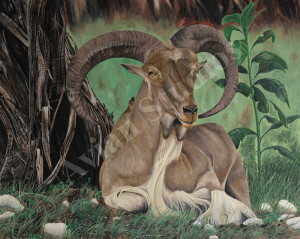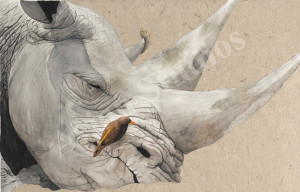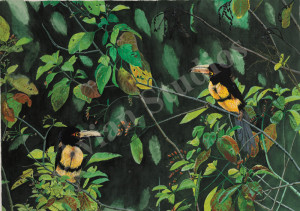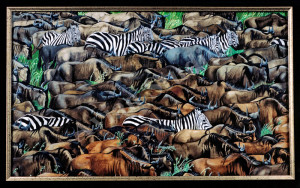Aoudad
150 Limited Edition
15 Artists Proofs
Available as 32“ X 40” and 20” X 25“ Giclée Reproductions
Framed and matted reproductions available

The ‘aoudad’ or barbary sheep (Ammotragus lervia) originated from the rocky arid mountains of Northwestern Africa. Not surprisingly, these sheep have successfully proliferated in the hill country of Central Texas as an introduced species. The strong and agile sheep are shy but can occasionally be seen darting up a hillside only to be lost from view within seconds. The painted aoudad is resting quietly next to an ashe juniper (Juniperus ashei), or post-cedar or cedar, another species that seems well-suited for the hill country. The ‘model’ aoudad was spotted at close range while driving through the Fossil Rim nature park in Glen Rose, Texas.
Rhinoceros and oxpecker
175 Limited Edition
20 Artists Proofs
Available as 13“ X 20” Giclée Reproductions
Framed and matted reproductions available

‘Rhinoceros and oxpecker’ depicts a lazy day. The black rhinoceros (Diceros bicornis), which is smaller than its cousin the white rhinoceros (Ceratotherium simum), occupies sporadic locations in sub-Sahara Africa. Because of the demand for rhino horn and other threats potentially leading to extinction, these magnificent animals are closely protected in several nature preserves in Africa. Yellow-billed oxpeckers (Buphagus africanus) are found commonly throughout sub-Sahara Africa. While original reports describe these birds as beneficial by removing skin parasites on other animals, more recent observations suggest otherwise. These birds have a darker side and have been seen to lap up blood caused by wounds from parasites and trauma. This rhino is resting in mid-day while the oxpecker searches for a meal.
Two collared aracaris

Cover art: Journal of Avian Medicine and Surgery. 2001;15(3):Cover.
175 Limited Edition
20 Artists Proofs
Available as 14“ X 20” Giclée Reproductions
Framed and matted reproductions available

‘Two collared aracaris’ (Pteroglossus torquatus), is based on the artist’s trip to Guatemala. These colorful birds are the most common of the toucanets or ‘mini toucans’ and are found throughout Central America. Their chatter is best described as ‘chipmunk like’ with a mixture of squeaks and whistles and is quite fitting for a jungle. The artist watched a large group of collared aracaris playfully chattering behind the Temple of the Giant Jaguar in the world-renown Mayan ruins of Tikal, Guatemala. Their carefree interactions made it seem as though the birds were blissfully unaware of the dangers surrounding them. It only seemed fitting to paint these two birds looking and interacting with each other with the dark and uncertain jungle behind them.
Zebras and wildebeest
125 Limited Edition
15 Artists Proofs
Available as 19“ X 32” Giclée Reproductions
Framed and matted reproductions available

‘Zebras and wildebeest’ represents a small segment of the massive animal migrations in Africa. Both the common wildebeest (Connochaetes taurinus), or brindled gnu, and common zebra (Equus burchellii), or plains or Burchell’s zebra, reside primarily within Southeastern Africa. After the rains stop, the herds of wildebeest, consisting of up to thousands of animals, search for greener pastures. The conspicuously admixed zebras are commonly seen within the wildebeest herd. The massive size of the herd likely provides protection against lions and other predators for both species. This painting was based on the superb photography of the Japanese born Mitsuaki Iwago.
